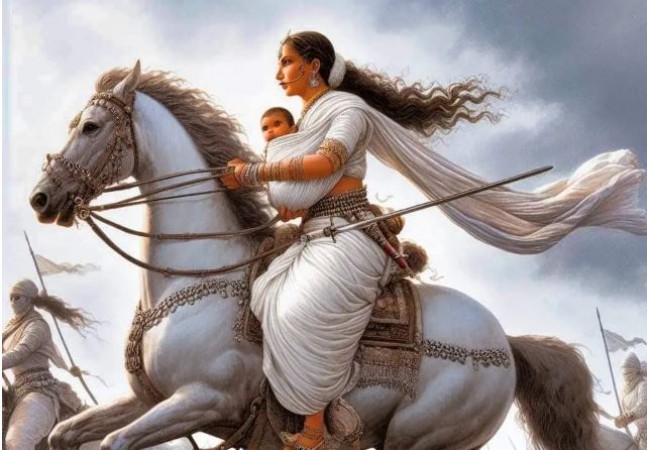
Jhansi: Rani Lakshmi Bai, also known as Laxmi Bai, was born on November 19, 1835, in Kashi (Varanasi) into a Brahmin family. Her father, Moropant Tambe, worked for Peshwa Baji Rao II. She died on June 18, 1858, at Kotah-ki-Serai near Gwalior during a valiant battle against the British East India Company. As the queen of the Maratha princely state of Jhansi, located in present-day Uttar Pradesh, she became a prominent figure in the Indian War of Independence in 1857, symbolizing resistance against British rule.
Originally named Manikarnika Tambe and affectionately called Manu, she was born to Moropant Tambe and Bhagirathi Sapre, a Marathi Karhade Brahmin couple. Her mother passed away when she was just four years old. Manu's father worked for Peshwa Baji Rao II in Bithoor, who nicknamed her "Chhabili" for her playful nature. Educated at home, she grew up more independent than most girls her age, excelling in shooting, horsemanship, fencing, and mallakhamba, alongside her friends Nana Sahib and Tatya Tope.
In 1842, she married the Maharaja of Jhansi and was renamed Rani Lakshmibai in honor of the Goddess Laxmi. Following her husband's death, she led a fierce resistance against the British, ultimately dying on June 18, 1858. Her loyal troops ensured her body was taken away, honoring her wish to avoid capture by the British. Rani Lakshmibai became a leading symbol in the 1857 War of Independence.
She often rode on horseback, sometimes with a small escort or in a palanquin, and was known for her horses, Sarangi, Pavan, and Baadal. Historical records indicate she rode Baadal during her escape from the fort in 1858. Her palace, the Rani Mahal, is now a museum.
Battle at Jhansi and Final Sacrifice
The British attacked Jhansi on March 21, 1858. Despite requesting reinforcements from Tatya Tope, his forces were defeated. Rani Lakshmibai personally supervised the defense of the fort. On April 3, 1858, General Rose stormed the fort, and by April 5, Jhansi had fallen under British control. According to historian S.N. Sinha, Rani Lakshmibai, disguised as a man, left the fort on April 4 or 5 and headed towards Kalpi, where the revolutionaries planned a resistance that ultimately failed. They then moved to Gwalior, achieving initial success. On June 18, 1858, the British attacked again, leading to a retreat and her death in the ensuing battle. General Rose reported that she ordered a funeral pyre and lit it herself. Another account suggests she chose death over living under British rule.
Twenty years later, Colonel Malleson wrote in “History of the Indian Mutiny” that despite her faults from the British perspective, her countrymen would remember her as someone who, driven by ill-treatment, rebelled and lived and died for her country.
Rani Lakshmibai's bravery, courage, and fighting spirit are commemorated with numerous statues across India. Institutions named in her honor include Lakshmibai National University of Physical Education in Gwalior, Laksmibai National College of Physical Education in Thiruvananthapuram, and Maharani Laxmi Bai Medical College in Jhansi. The Rani Lakshmi Bai Central Agricultural University in Jhansi was established in 2013, and the Rani Jhansi Marine National Park is located in the Andaman and Nicobar Islands. A women’s unit of the Indian National Army was named the Rani of Jhansi Regiment. In 1957, two postage stamps commemorated the centenary of the rebellion. Rani Lakshmibai's dedication to Indian independence is celebrated in novels, poetry, and film, solidifying her legacy as a hero of India's fight for freedom.
Temperatures Soar to 45 Degrees Celsius in Northern Rajasthan
When Does Jordan Peele's Fourth Movie Release in Theaters?
Breaking! Fire Breaks Out at Garments Factory in Delhi's Gandhi Nagar, Dousing Operation Underway